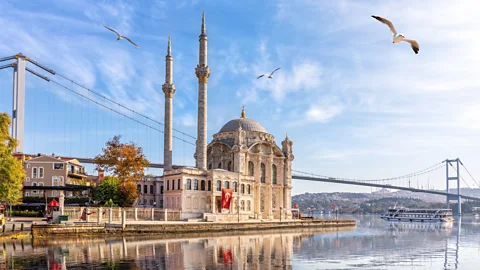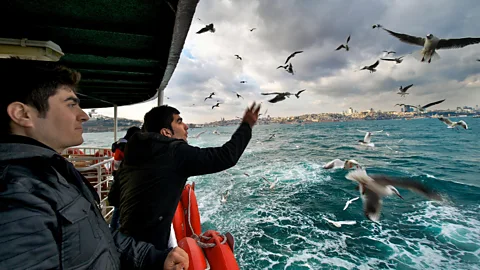The most Istanbul thing to do in Istanbul
14th December 2023, 08:00 EST
By Joshua LevkowitzFeatures correspondent
 Anton Petrus/Getty Images Anton Petrus/Getty Images
(Credit: Anton Petrus/Getty Images)
Moreso than any monument, museum or tour, taking a ferry helps visitors not only understand Istanbul, but fall in love with it.
In many ways, the Bosporus Strait that bisects Istanbul is a metaphor for the Turkish city itself. Its predecessor, Constantinople, rose from the Bosporus' banks to become the seat of the Roman, Byzantine and Ottoman empires, making it the only place in history to have been the capital of consecutive Christian and Islamic empires. Thanks to the strait that it straddles, Istanbul is the only city in the world spanning two continents – a cultural and geographical bridge between East and West.
While many Ottoman sultans proposed building an actual bridge across the Bosporus, it was boats – and later ferries – that were responsible for connecting the city. The first bridge that united the two continents wasn't built until 1973. All the while, ferries flitted back and forth across the strait, linking the city's diverse Turkish, Greek, Armenian, Arab, Bulgarian, Jewish and Russian populations.
Today, Istanbul is a sprawling, 15.5-million-person megalopolis (the largest in Europe), surrounded by a network of waterways that bound and divide it. The city rises atop seven hills, showcasing everything from Byzantine palaces and melon-coloured Ottoman mosques to Armenian-inspired opera houses, Anglican churches and metallic modern art museums. As men push wooden carts along the city's cobblestone alleys, hipsters and tourists bop in and out of sybaritic nightclubs and pubs until the early morning. Here, the past, present, Europe and Asia are all one.
Because of its unique location and sheer size, Istanbul has always been a place best seen from the water. In fact, only from the upper deck of one of the city's many public ferries can you begin to appreciate its breadth and best notice its confluence of cultures. It is simply too big to understand by land. So, while many visitors beeline to Istanbul's Historic Peninsula to see the Hippodrome of Constantinople, the Hagia Sofia mosque and the Topkapi Palace, boarding a ferry not only lets you see many of these sites framed by sweeping vistas, but it also helps visitors understand how the city's layered past fits into its dynamic present.
 agefotostock/Alamy agefotostock/Alamy
Istanbul is Europe's largest city and has always best been viewed from the water (Credit: agefotostock/Alamy)
Since many visitors have historically approached Istanbul from the water, its ferries allow travellers to view many of the city's most iconic sites as they were once seen – including views of the Turkish Rococo-style Dolmabahce Palace, the nearly 2,400-year-old Maiden's Tower and the splendid Haydarpasa railway station.
Practical info
Istanbul's public ferry connects riders at 50 different pier locations throughout the city. Each ride costs between 15-45 Turkish lira (£0.41-£1.24) depending on the distance. Download the ferry's easy-to-use app to plan your trip.
Istanbul's ferries have also helped shape the city's unique culture and development. As Istanbul's population swelled in the mid-19th Century, the introduction of public ferries in 1844 allowed people living along the Bosporus Strait, the nearby Marmara Sea inlet and the Golden Horn estuary to easily commute between Istanbul's various waterside neighbourhoods. In the 1970s, as residents of central and eastern Anatolia migrated to Istanbul in search of employment, bringing their different languages and food customs with them, many crossed to the European continent for the first time on one of the city's ferries.
Today, tourists can ride the ferry from the Asian pier of Kadiköy to the European edge of Karaköy. Flanked by the famed Galata Tower and bridge, the ride reveals how Istanbul is one of the world's great cultural melting pots. Onboard, you're likely to hear Greek, Armenian and languages from across the Caucasus. Performers often belt out Arabesque tunes on their darbuka drums, while Kurdish musicians perform on their lute-like elektrobaglama,as passengers cross continents. Perhaps more than anywhere else, a ferry ride allows you to glimpse Istanbul's deep and diverse roots in full focus.
Ferries can also easily whisk travellers to hard-to-reach neighbourhoods. For instance, the delightful seaside village of Kanlica could take more than two hours to reach by land transport from the Historic Peninsula. But because Kanlica has its own ferry pier, where you can sit in a delightful cafe and try the area's famous Kanlica yogurdu (yoghurt sprinkled with powdered sugar), travellers can avoid Istanbul's notorious traffic and arrive from the Historic Peninsula in just an hour. There are also hourly trips to four of the Princes' Islands in the Sea of Marmara, which are completely inaccessible by land. There, you can rent bicycles, go for a swim and eat fried fish and drink aniseed-flavoured raki (Turkey's national drink) before heading back in time for an evening in the city.
Click the play button above to watch the video "The one obsession everyone in Istanbul has"Over the years, passengers have also developed their own rites and rhythms aboard the city's ferryboats. Ride in the morning, and you're likely to spot commuters grabbing a circular, sesame simit bagel or a poagaca pastry before boarding the ship. They then sit side by side with strangers, ordering one another gilt-rimmed glasses of tea and swapping newspapers before the start of their workdays.
Recommended routes
Take the Kabatas-Princes Islands line to Burgaz Island to see the house museum of Sait Faik, one of Turkey's greatest writers, and then rent a bicycle to get lost among the pine trees before visiting Kalpazankaya beach. If you have less time, consider the Besikitas-Eyup ferry line to enter the Golden Horn inlet. At Eyup, you can take a brief gondola ride up Pierre Loti hill for a sunset tea.
"Ferries continue to be the symbol of Istanbul. Ferries carry not only passengers but also the culture, traditions and habits of the society," wrote Adil Bali, a local journalist. "Listening to the concert of street musicians at the ferry dock, leaning on the railings on the ferry… reading newspapers or books while sipping tea, and watching the painting of Istanbul where the seagulls dance are all part of this culture."
Istanbul's public ferries carry roughly 40 million passengers a year, making the Bosporus one of the world's busiest waterways. But in addition to the many mosques and minarets lining the shores, passengers may also see pods of dolphins, shearwater birds and one of the city's most ubiquitous creatures: seagulls. The birds are known to glide alongside the ferries, and they've become so synonymous with the boats that Sehir Hatlari, the ferry's operating company, adopted seagulls' black, white and yellow-beaked colours on its logo.
"If you wish to experience a local custom about a ferry trip, don't forget to buy at least two simits before you start it. One for you and another for seagulls. Throw the little simit pieces and see how masterful Bosporus seagulls catch them in the air," said local tour guide Aysegul Elif Sofuoglu.
 MB Images/Alamy MB Images/Alamy
Seagulls are synonymous with Istanbul's ferry system (Credit: MB Images/Alamy)
In addition to sightseeing and wildlife spotting, Istanbul's ferries also provide incomparable people watching. Look around and you'll inevitably notice the many people who call Istanbul home: well-heeled businessmen in suits, hawkers from Anatolia trying to sell trinkets to Iranian tourists, elderly Turkish women in pearls sharing cookies with their compatriots in headscarves, and so much more.
"Despite the changing times, as society divides along cultural issues, ideologically left or right, religious or not, the love of ferries remains one of the key themes for the city residents," said Yörük Isik, who rides Istanbul's ferries several times a week. "It's one of the few binding experiences that we still have."
In a city where street vendors shout their inventory, oil tankers plying the Bosporus blare their horns and the amplified call of five daily prayers rings from thousands of mosques, ferries also offer a meditative escape from Istanbul's barrage of noise.Hikmet Sirlak rides the ferry to feel the cool breeze and the smell of the salty seas. He loves the ferries so much that he decided to move to the Asian banks of the city so he could commute by boat to the Grand Bazaar, where he sells antique carpets and kilims.
"People usually look down at the ground to and from work, but here I get to look up," he said, watching the waning yellows and oranges from the sunset aboard a ferry.
 Burak Karademir/Getty Images Burak Karademir/Getty Images
Ferries also provide some of the best people-watching experiences in Istanbul (Credit: Burak Karademir/Getty Images)Some of Istanbul's decommissioned ferries have gone on to become cafes, museums, hotels and wedding halls. Others have been renovated in the historical Haliç shipyard, which has been active since 1455 and is the oldest in the world. And in a city where waterfront real estate is quickly snatched up by developers, the ferry piers offer some of the last bits of public seafront access, including floating exhibition spaces and libraries.
Moreso than any monument, museum or tour, taking a ferry helps visitors not only understand Istanbul, but fall in love with it. Sinem Dedetas, head of Istanbul's ferry line, thinks this is why the boats have inspired poems, paintings, novels, songs and films for nearly 200 years. "The best way to discover Istanbul," she said, "is to hop on a ferry and watch the Bosporus!"
bbc.com |





 Anton Petrus/Getty Images
Anton Petrus/Getty Images agefotostock/Alamy
agefotostock/Alamy MB Images/Alamy
MB Images/Alamy Burak Karademir/Getty Images
Burak Karademir/Getty Images